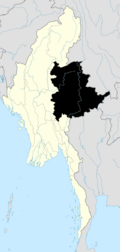Kutkai
Kutkai
ကွတ်ခိုင် | |
|---|---|
Town | |
 | |
| Coordinates:23°27′N97°56′E/ 23.450°N 97.933°E | |
| Country | |
| State | |
| District | Mu Se District |
| Township | Kutkai Township |
| Time zone | UTC+6.30(MST) |
Kutkai(Burmese:ကွတ်ခိုင်kwat hkuing[kʊʔkʰàɪɰ̃]) is a town and seat ofKutkai Township,in theShan Stateof eastern-centralBurma.It lies alongNational Highway 3,approximately 24 kilometres to the north ofLashio.[1][2]
History[edit]
In the early 20th century, the area around Kutkai was explored by British botanists. In 1912, Stephenson documented that he had found the earthworm speciesPheretima molestaof the genusPheretimain Katkai.[3]
Shan State became a major Christian area of Burma in the mid-19th century.[4] Kutkai was an important centre for theKachin Baptist Churchand was visited by missionaries, notably Baptist ReverendGeorge J. Geisin the 1930s andGustaf A. Swordfrom 1936 to 1942.[5][6] Geis died in Kutkai on October 28, 1936 whilst he was working there at the Kachin Bible Training School he had established.[7]

DuringWorld War II,Kutkai was occupied by the Japanese. On September 10, 1944, the Chinese Fourteenth Air Force sent out 45B-25 Mitchellsto bomb Kutkai along with the towns ofTunganhsien,Lingling andTunghsiangchiao.[8]but the town was abandoned without a fight when the Chinese reached it on February 19, 1945.[9]
In July 1954, Hoo Kya Chin, aKokangbusinessman fromMu Kwanwas arrested by the immigration officials in Kutkai for not carrying an identification card which caused some controversy in the region.[10]
In the 1980s, two privates and a sergeant of theKachin Independence Armyinsurgent 4th Brigade surrendered at Kutkai garrison.[11]
On 7 January 2024, the town was captured by theThree Brotherhood Alliancefrom theState Administration CouncilduringOperation 1027,an offensive launched during theCivil War.[12]
Geography[edit]

Kutkai is situated in eastern-central Burma, several kilometres by road north ofHsenwiand about 24 kilometres (15 mi) north ofLashio.It lies at an altitude of 4,800 feet (1,500 m). To the east of Kutkai is theNam Ting Riverand theSalween River.
It sits on Mandalay-Lashio-Muse road aka Asian Highway route 14 (AH14). It is 222 miles (357 km) fromMandalay,58 miles (93 km) fromLashioand 68 miles (109 km)toMuse.Kutkai-Tarmoene road is 17 miles (27 km), Kutkai-Kaungkha road is 8 miles (13 km), Kutkai-Manbyien road is 8 miles (13 km) and Kutkai-Karlaing road is 8 miles (13 km) also.[13]
Economy[edit]
As with many parts of Burma, the economy relies on agriculture, particularly rice production. Villagers in Kutkai Township are generally well educated in farming practices and in canning-bottling.[14]Of major note is theKutkai Marketin the town where people come from miles to sell their goods.Kutkai High Schoolis located in the southern part of the town. The town also contains theKutkai General Hospital.
In the 1990s, Kutkai township was exposed as a major rawopiumproducing area. From September 1996, theU.S. Department of Statefunded $530,000 and established agricultural cooperatives in 25 villages in Kutkai township to crack down on the illegal drugs trade by promoting the growth of buckwheat, wheat, potatoes and other vegetables.[15]Large quantities of opium were confiscated from the houses of villagers in the area in the summer of 1999.[16]On July 31-August 1, 2003, a refinery was raided in Kutkai Township between the villages ofNamhsaungkyeandNampyinrevealing 62.452 kilos ofheroin,36.4 kilos of raw opium, 661.5 litres oflysol,135 kilos ofether,2,844 litres ofchloroform,202.5 litres ofhydrochloric acid,972 litres ofacetic anhydrite,2,975 kilos ofammonium chloride,500 kilos ofsodium carbonate,500 grams ofpotassium chlorideand 3.6 kilos ofsodium,various weapons and 13 implements used in the refining of narcotic drugs.[17]
References[edit]
- ^Google Maps(Map). Google.
- ^Bing Maps(Map).MicrosoftandHarris CorporationEarthstar Geographics LLC.
- ^Records of the Indian Museum, Volume 34.Indian Museum,(Calcutta, India),Zoological Survey of India,The Museum; Manager of Publications, Govt. of India Press. 1932. p. 435.
- ^"History of Shan Churches"(PDF).Shan Missions.RetrievedNovember 8,2010.
- ^Herman G. Tegenfeldt (1974).A century of growth: the Kachin Baptist Church of Burma.William Carey Library.ISBN0-87808-416-9.
- ^Contributions to Asian studies, Volumes 13-16.E. J. Brill. 1979. p. 143.ISBN90-04-05882-6.
- ^Annual report...American Baptist Foreign Mission Society. 1937. p. 54.
- ^Keith D. Dickson (2008).World War II Almanac, Volume 2.Infobase Publishing. p. 700.ISBN978-0-8160-6297-3.
- ^Time Runs Out in CBI.Government Printing Office. 1953. p. 227.ISBN978-0-16-088231-9.
- ^Yang, Li (1997).The house of Yang: guardians of an unknown frontier.Bookpress. p. 72.ISBN978-0-646-32859-1.
- ^Summary of world broadcasts: Far East, Part 3.Monitoring Service of the British Broadcasting Corp. 1987.
- ^"Myanmar's Brotherhood Alliance Seizes Two More Towns in Shan State".
- ^"Welcome to MRTV-3".Archived fromthe originalon 2011-09-29.Retrieved2011-06-20.
- ^Richard T. Arndt; David Lee Rubin (1996).The Fulbright difference.Studies on cultural diplomacy and the Fulbright experience, Transaction Publishers. p. 22.ISBN1-56000-861-X.
- ^"Current Projects of OSS-101 Association, Inc".OSS.RetrievedNovember 8,2010.
- ^"Opium, arms seized in Kutkai".Burma Library. August 18, 1999.RetrievedNovember 8,2010.
- ^"Opium refinery exposed in Kutkai Township".The New Light of Myanmar.August 14, 2003. Archived fromthe originalon 2005-01-29.RetrievedNovember 8,2010.



